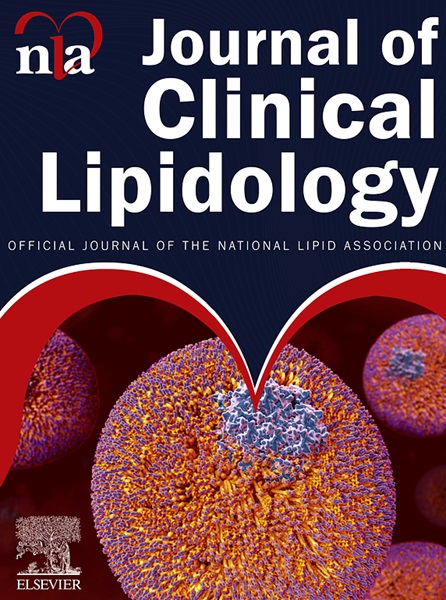Atherogenic lipoproteins associate with loss of glycemic control in youth-onset type 2 diabetes: Results from the TODAY study
IF 4.6
3区 医学
Q2 PHARMACOLOGY & PHARMACY
引用次数: 0
Abstract
BACKGROUND
Type 2 diabetes (T2D) in adolescents is associated with an unfavorable lipid profile, but lipoprotein particle subspecies and branched-chain amino acid (BCAA) data are scarce.
OBJECTIVE
To evaluate lipoprotein particle distributions, lipoprotein insulin resistance index (LP-IR), and BCAA levels longitudinally and their relationships with sex, race/ethnicity, treatment, and loss of glycemic control in adolescents with youth-onset T2D.
METHODS
Participants from the TODAY study (n = 348) had samples analyzed yearly for glycated hemoglobin and nuclear magnetic resonance lipoprotein and BCAA assessments.
RESULTS
At baseline, participants with T2D were 13.7 years old with T2D, obesity, and from racial and ethnic minority groups (32.2% Non-Hispanic Black [NHB], 43.7% Hispanic). Smaller low-density lipoprotein (LDL) and larger very low-density lipoprotein (VLDL) sizes, higher high-density lipoprotein (HDL) particle number, and increased LP-IR score predicted worsening of glycemic control. LDL, HDL, and VLDL particle numbers increased over 3 years with weaker trends for decreasing LDL and HDL size. LP-IR and BCAA levels were higher longitudinally in those who lost glycemic control. Females had larger HDL size than males at baseline and throughout. NHBs had the largest LDL and HDL sizes, smaller VLDL size, and lower LP-IR and BCAA.
CONCLUSION
These data in youth with T2D demonstrate a progressive atherogenic lipoprotein phenotype over 3 years. Increased LP-IR and BCAA are associated with worsening glycemic control and may be contributing to the premature development of atherosclerosis in youth with T2D.
致动脉粥样硬化脂蛋白与青年 2 型糖尿病患者血糖失控有关:TODAY 研究的结果。
背景:青少年2型糖尿病(T2D)与不利的脂质谱相关,但脂蛋白颗粒亚种和支链氨基酸(BCAA)的数据很少。目的:探讨青少年早发型T2D患者的脂蛋白颗粒分布、脂蛋白胰岛素抵抗指数(LP-IR)和BCAA水平与性别、种族/民族、治疗和血糖控制丧失的关系。方法:来自TODAY研究的参与者(n = 348)每年对样本进行糖化血红蛋白、核磁共振脂蛋白和BCAA评估。结果:在基线时,参与者年龄为13.7岁,患有T2D,肥胖,来自种族和少数民族群体(32.2%非西班牙裔黑人[NHB], 43.7%西班牙裔)。低密度脂蛋白(LDL)和极低密度脂蛋白(VLDL)尺寸较小,高密度脂蛋白(HDL)颗粒数较高,LP-IR评分升高预示血糖控制恶化。LDL、HDL和VLDL颗粒数在3年内增加,而LDL和HDL颗粒大小减少的趋势较弱。在失去血糖控制的患者中,LP-IR和BCAA水平纵向较高。在基线和整个过程中,女性的HDL比男性大。NHBs具有最大的LDL和HDL大小,较小的VLDL大小,较低的LP-IR和BCAA。结论:这些数据表明,青年T2D患者在3年内出现了进行性动脉粥样硬化性脂蛋白表型。LP-IR和BCAA升高与血糖控制恶化有关,可能导致青年T2D患者动脉粥样硬化的过早发展。
本文章由计算机程序翻译,如有差异,请以英文原文为准。
求助全文
约1分钟内获得全文
求助全文
来源期刊
CiteScore
7.00
自引率
6.80%
发文量
209
审稿时长
49 days
期刊介绍:
Because the scope of clinical lipidology is broad, the topics addressed by the Journal are equally diverse. Typical articles explore lipidology as it is practiced in the treatment setting, recent developments in pharmacological research, reports of treatment and trials, case studies, the impact of lifestyle modification, and similar academic material of interest to the practitioner.
Sections of Journal of clinical lipidology will address pioneering studies and the clinicians who conduct them, case studies, ethical standards and conduct, professional guidance such as ATP and NCEP, editorial commentary, letters from readers, National Lipid Association (NLA) news and upcoming event information, as well as abstracts from the NLA annual scientific sessions and the scientific forums held by its chapters, when appropriate.

 求助内容:
求助内容: 应助结果提醒方式:
应助结果提醒方式:


